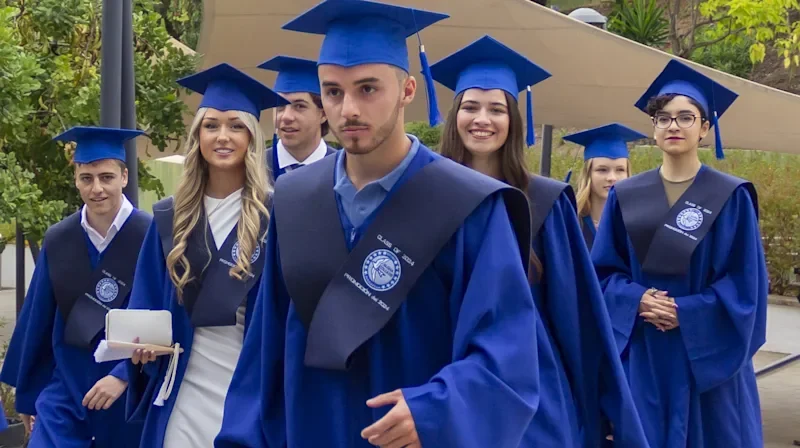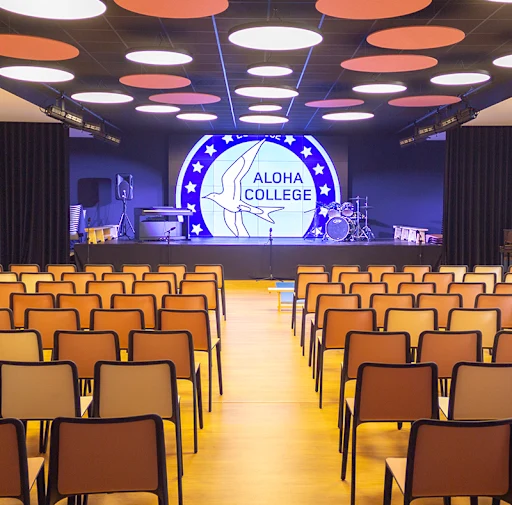
Top Schools in Nueva Andalucía and What Moving Families Should Know
Natalia Tschurtschun | · 20 min. read
Relocating to the Costa del Sol with children is as much about home location as it is about schooling. In particular in Marbella the choice of school often influences which residential area you’ll select, finding the top schools in Nueva Andalucía is key and how your everyday lifestyle plays out. Nueva Andalucía has emerged as one of the most family-friendly zones: a good international school ecosystem, strong community amenities, and a lifestyle that suits both parents and children. In this article we’ll review three of the leading international schools in the area, including detailed profiles, approximate fee ranges, waiting list notes, and then shift into what parents relocating should know about curriculum, admissions, transport, home choice and broader lifestyle matters.
Why Nueva Andalucía is a Strong Choice for Families
Nueva Andalucía sits just inland from the coast and the marina of Puerto Banús, yet still offers easy access to beaches, golf courses, shopping and dining. For families moving in with children the area is appealing for several reasons:
- There is a substantial international community, meaning your children will likely meet other kids from a variety of nationalities and have a supportive expat network.
- The area is served by several respected international schools – meaning you have real choice of curricula (British, IB, bilingual Spanish/English) rather than being locked into one local system.
- On the property side you’ll find that proximity to good schools is increasingly seen as a premium attribute. For families, commuting time, school bus routes, daily routine matters more than one might at first imagine.
- Lifestyle-wise the area ticks the boxes: outdoor living, family friendly amenities, good access to medical, shopping, parks, and internationally minded services.
In short, if you are moving to Marbella with children and education is a high priority, it makes sense to place the school decision at the heart of your relocation planning and approaching it from the viewpoint of “school first, then home” often reduces compromise and frustration.
School Profile 1: Aloha College Marbella - Top Schools in Nueva Andalucía

Location & overview
Aloha College Marbella is located in Urbanización El Ángel, Nueva Andalucía, 29660 Marbella. It is a not-for-profit international school with ages 3-18. It offers a British curriculum (IGCSE/A-Levels) and the International Baccalaureate Diploma in the Sixth Form years.
Curriculum & strengths
Because it covers the full age range it allows families to have their children stay at one institution from early years all the way through to university-entrance stage. The mix of British curriculum and IB Diploma provides flexibility for university destinations in the UK, Europe or beyond. The school emphasises a multicultural environment and strong extra-curricular offerings.
Fees and table
Here is an approximate fee table based on publicly available sources:
Age/Year group Approximate annual day fee (€)
Early years to lower primary ~ €7,000
Middle years up to IGCSE ~ €10,000-€15,000
Sixth Form / IB Diploma years Up to ~ €17,000 or more
Actual current year fees should always be verified with the school directly. Aloha’s published data suggests fees in the range of about €7,075 to €17,180 for a typical year.
Waiting list & admissions commentary
The school states that waiting lists will be in place once a year group is full and they recommend applying early (around 10-12 months ahead). Because of popular demand families should plan ahead. As part of the admissions process they require previous school reports, appropriate English level (if transferring from outside a British curriculum), and interviews or assessments for some year groups.
Why families choose Aloha
One campus from early years through to 18 means children do not need to change school mid-journey unless by choice.
Well-regarded academic reputation and full breadth of curriculum.
Located in the heart of Nueva Andalucía which suits families living in that zone.
Good balance of academics, personal development and extracurricular.
Considerations for relocation
Because it is popular, securing a place may take advance planning – wait-list slots fill up.
Check whether transport/bus service is convenient for your specific home location.
The upper end of fees is higher than some other schools, so budget accordingly.
School Profile 2: Swans International School

Location & overview
Swans International School serves ages 3-18. The school has a primary campus and a secondary campus (the secondary located in Sierra Blanca though serves families in Nueva Andalucía and surrounding zones). It follows the British national curriculum up to IGCSE and then offers the IB Diploma programme for 16-18 years.
Curriculum & strengths
This school is known for a strong IB offering, good facilities, bilingual environment (English/Spanish) and an international student body. For families seeking the IB path it is one of the most referenced options in the region.
Fees and table
Approximate fee ranges:
Age/Year group Approximate annual day fee (€)
Primary years ~ €8,700 and upwards
Secondary years up to IGCSE ~ €10,000-€16,000
Sixth Form / IB Diploma Up to ~ €21,000
One school directory lists day fees from €8,721 to €21,000. Another source gives a range around €7,000-€16,000 depending on grade level.
Waiting list & admissions commentary
Swans invites enquiries year-round but emphasises that spaces fill fast especially in key years. Being older than some schools means that mid-year transfer may require assessment of English and previous school report. Families relocating should check transport logistics, if the home is in an outlying part of Nueva Andalucía or surrounding zone, commuting may factor into daily rhythm.
Why families choose Swans
- Full age range with strong IB path for university.
- Bilingual culture likely helps children from non-English-speaking backgrounds integrate.
- Established reputation for international schooling in Marbella region.
Considerations for relocation
- The campus for secondary years is in Sierra Blanca, so commuting needs checking if you live elsewhere in Nueva Andalucía.
- Fees at the upper end are significant; budget accordingly.
- Because it is popular for IB, competition can be greater for the Sixth Form years.
School Profile 3: Laude San Pedro International College
Location & overview
Laude San Pedro International College is in San Pedro de Alcántara (nearby), which makes it a viable option for families living in Nueva Andalucía as well. It offers education from approximately age 3 to age 18, blending British and Spanish curricula in a bilingual English/Spanish environment.
Curriculum & strengths
For families specifically seeking a bilingual Spanish/English school rather than purely British, this school offers strong flexibility. The curriculum is oriented toward both Spanish and international programmes, preparing students for universities in Spain and abroad. The campus is well-equipped with modern facilities.
Fees and table
Exact published figures are not fully available for all year groups. Based on the admissions page, families are encouraged to request a pack. While full fee tables were not publicly disclosed, typical fees for comparable bilingual schools in the region range from ~€5,000-€9,000 for lower years in some cases (though for upper years it will be higher). Because detailed fee breakdown was not published, families should inquire directly.
Waiting list & admissions commentary
The admissions process is open throughout the year. Being less limited purely to an international expat group and more bilingual in character may mean slightly different demand dynamics. Nevertheless popular years may fill, especially for entry years (Year 1, Year 7, Sixth Form). Visiting early, establishing interest and securing a place early is advisable.
Why families choose Laude San Pedro
- Strong bilingual offering suits families with Spanish speakers or those who want their children to maintain Spanish language and cultural connection.
- Flexibility of curriculum – blends British and Spanish pathways.
- Excellent facilities and good reputation in the region.
Considerations for relocation
- Commute from some parts of Nueva Andalucía may be longer than schools centrally placed. Checking drop-off, bus routes and after–school club logistics is important.
- Fee transparency means you will need to ask the school directly for full current year fees.
- For families wanting purely British curriculum or pure IB track, compare if this school offers precisely the pathway you seek.

Practical Relocation Considerations for Families
When moving to Nueva Andalucía and schooling is one of your priorities there are a number of key matters to consider beyond simply picking a school name. These can determine how happy you are in your daily life and how smoothly your children transition.
Curriculum fit & future destinations
- Decide early whether your child will follow a British curriculum (IGCSE/A-Levels), the IB Diploma, or a bilingual Spanish/English path. Each has slightly different university destination implications and adaption for children moving from abroad.
- If you anticipate your child will enter university in the UK, then British curriculum or IB may have advantages. If you anticipate staying in Spain or Europe it may make sense to include strong Spanish curriculum elements.
- For families relocating mid-journey (for example from a national school system) check how the school will assess your child’s previous school reports and whether they will integrate quickly.
Admissions timing & waiting lists
- Many of the top schools in this region implement waiting lists once a year group is full. For example Aloha College explicitly says waiting lists apply when year groups fill.
- Applying early is key. For many schools the recruitment window opens 10-12 months before the start of the academic year. Families relocating from abroad should plan applications well ahead of physical move.
- Be aware of deposit or registration fees. Some schools require non-refundable waiting list deposit or registration payment to secure place.
- For mid-year entry or transfer from a different system you may need to provide previous school report, English language evidence (for non-English mother-tongue students) and possibly sit assessment tests.
Transport, commuting & lifestyle
- Even within Nueva Andalucía commuting time matters a lot. If your home is located further inland or on the outer edge of the zone and the school is closer to the coast or vice-versa your daily drop-off/pick-up commute may lengthen significantly.
- Check whether the school offers bus transport, and whether the bus route suits your area of residence or if you will need to drive and park. Traffic at peak times can add to travel cost/time.
- After-school clubs, sports, music and extra-curricular activities extend the day. Families should check how those align with their lifestyle and whether child care or driver will be needed.
Housing choice & school proximity
- For families relocating, selecting your home location with the school in mind is often wise. Being closer to the school means less time commuting, more free time for children, and less stress for parents.
- It’s important to balance housing budget, neighbourhood serenity, amenities (parks, supermarket, medical) and school access. Nueva Andalucía offers neighbourhoods from family villas to apartments.
- Because schooling choice influences property choice and lifestyle, you may want to start your property search in tandem with your school application rather than sequentially.
Integration & community support
- Children changing countries or languages will adapt better if the school has a vibrant international student body, strong language support and after-school social activities.
- Visiting the school before move, engaging with the admissions/parent relations team, and perhaps meeting other relocating families can ease the transition.
- Consider what support the school offers for newcomers: extra-language tutoring, buddy systems, orientation, homeroom teacher support.
Budgeting for fees & extras
- As shown in the tables above, fees can vary significantly by year group and school. Upper years (Sixth Form/IB) can be significantly more expensive.
- School fees may not include extras: transport, lunches, trips, uniforms, exam fees may all be additional. Be sure to ask for a full breakdown.
- Some schools will increase fees annually or have inflation-related increases – check historical increases.
- Plan for other costs: commuting (bus or car), after-school activities (sports, music), possible tutoring if your child needs to adjust curriculum.
Summary: What to Do Next
- Define your priorities: curriculum, university destination, bilingual vs purely English, commute time.
- Short-list two to three schools in the zone (you have at least three good ones here) and schedule visits or virtual tours.
- Apply early: Gather previous school reports, proof of English level if required, choose suitable academic year for entry.
- Search for home in parallel with school application: verify commute, transport, neighbourhood amenities.
- Budget realistically: include school fees + extras + housing + transport.
- Prepare children’s transition: language support, familiarise with school culture, meet potential classmates, sort out after-school activities.
- Keep contingency plans: If your first choice school has a waiting list or you are relocating mid-year, have alternative school(s) in mind and consider additional tutoring or language integration support.
Relocating with children is a major undertaking but also an opportunity to craft a life that supports education, wellbeing and lifestyle in equal measure. In Nueva Andalucía you are fortunate to have strong schooling options, a high-quality living environment and a family-friendly community. Focus early on the schooling decision, align your home choice accordingly, and you’ll increase your likelihood of a smooth relocation, happy children and a settled family life in Marbella.

Q&A: Moving to Nueva Andalucía and Choosing the Right School
Q1. Why do so many families moving to Marbella choose Nueva Andalucía?
Nueva Andalucía has become one of Marbella’s most desirable residential areas for families. It offers proximity to beaches, golf, restaurants, and Puerto Banús, yet remains quieter and more residential. The area is known for its excellent international schools, safe communities, and wide range of villas and apartments suited for family living. It also provides easy access to both the A-7 and AP-7 motorways, making commutes to Marbella centre, San Pedro, and Estepona convenient.
Q2. What are the top international schools in Nueva Andalucía?
The top three schools most families consider are:
- Aloha College Marbella – a well-established not-for-profit British and IB school (ages 3-18).
- Swans International School – a long-standing British and IB school with campuses serving Marbella and Sierra Blanca.
- Laude San Pedro International College – nearby in San Pedro, offering bilingual English-Spanish education (ages 3-18).
All three have strong reputations, diverse student bodies, and internationally recognised curriculums.
Q3. Which curriculum is best for my child – British, IB, or bilingual?
It depends on your long-term plans.
- If your child will attend university in the UK or other Commonwealth countries, the British curriculum (IGCSE and A-Levels) provides a direct pathway.
- If you prefer an internationally portable qualification accepted worldwide, the International Baccalaureate (IB) is ideal.
- For families staying in Spain or wishing for bilingual fluency, a British-Spanish bilingual system like Laude San Pedro’s offers both local integration and global flexibility.
Families often select schools based on how long they intend to live in Spain and their children’s future study destinations.
Q4. How much do schools in Nueva Andalucía cost?
Annual tuition varies depending on age and school. Below are approximate ranges for guidance:
School Early Years Middle Years Sixth Form / IB
Aloha College Marbella €7,000 €10,000–€15,000 €17,000+
Swans International School €8,700+ €10,000–€16,000 Up to €21,000
Laude San Pedro International €5,000–€9,000 €9,000–€13,000 (approx.) €14,000+ (estimate)
Additional costs may include registration fees, uniforms, exam fees, bus transport, lunches, and after-school activities.
Q5. Are there waiting lists for these schools?
Yes, waiting lists are common.
- Aloha College Marbella often has waiting lists for several year groups, especially Primary and Year 7 entry.
- Swans International recommends applying early due to limited Sixth Form spaces.
- Laude San Pedro tends to be slightly more flexible but still fills quickly for entry points such as Year 1 and Year 7.
It’s best to apply 10–12 months before your planned move. Many families even reserve a spot before securing housing.
Q6. How early should we apply if we’re relocating from another country?
Ideally, start the process as soon as relocation becomes a serious possibility.
- For September entry, apply between October and January of the previous year.
- Prepare school reports, references, and English-language certificates if applicable.
- Arrange virtual tours if you cannot visit in person.
Early communication with admissions helps assess year placement and available support for language transitions.
Q7. Do these schools accept students mid-year?
Most schools in the area will consider mid-year applications, but availability depends on the year group. Aloha and Swans accept transfers where space allows, often after reviewing previous school reports and conducting an assessment. Families moving for professional reasons during the school year should contact admissions directly as soon as relocation dates are confirmed.
Q8. How do these schools compare in class sizes and student diversity?
- Aloha College Marbella: around 850 students from 50+ nationalities. Average class size 20–22.
- Swans International School: smaller community feel, strong emphasis on academic excellence and multicultural integration.
- Laude San Pedro: around 800 students, 50+ nationalities, bilingual environment.
All three encourage internationalism, cultural understanding, and respect, helping children adjust easily when moving from abroad.
Q9. Are there school buses or transport services available?
Yes. All major schools provide transport covering most Marbella areas, including Nueva Andalucía, San Pedro, and even Estepona.
When house-hunting, it’s worth asking each school for their current bus route map. It can determine whether your preferred property is within their collection zone. If not, you may need to drive your child daily, which can add 20–30 minutes during rush hour.
Q10. Do schools offer after-school care or extracurricular activities?
Absolutely. Most schools in Marbella treat extracurricular programs as central to student life.
Common activities include football, tennis, swimming, art, robotics, debate, drama, and music.
Aloha College, for example, hosts strong sports clubs and performing arts; Swans focuses on creativity and leadership; Laude offers bilingual enrichment and team sports.
After-school activities usually have an additional fee but can greatly support language integration and social bonding.
Q11. How difficult is it for children to adapt to a new school here?
Most international schools in Nueva Andalucía have strong support systems for newcomers. They provide English-as-an-Additional-Language (EAL) programs, Spanish lessons for non-native speakers, and “buddy” systems to help new students settle in.
Because classrooms are filled with other international students, children quickly find peers with similar experiences, making adaptation smoother than in traditional national schools.
Q12. Can children continue their studies abroad later without issues?
Yes. All three schools prepare students for international university entry.
Aloha and Swans both offer the IB Diploma, one of the most widely accepted qualifications worldwide.
British IGCSE and A-Level results are recognised by UK, European, and North American universities.
Laude’s bilingual pathway ensures Spanish accreditation too, so students can pursue higher education within Spain if they wish.
Q13. What should parents look for when visiting schools?
When touring or joining virtual open days, focus on:
- Classroom environment and teacher-student interaction
- Language support for non-native speakers
- Facilities (science labs, arts, sports fields)
- Safety and wellbeing policies
- Student-to-teacher ratio
- Transport logistics and parking
- Feedback from other parents
Visits also help you sense whether the school culture fits your family’s values.
Q14. Are there any local community groups or parent networks?
Yes. Each international school has an active Parents’ Association (PTA) and community network. Nueva Andalucía also hosts several expat Facebook and WhatsApp groups for parents, offering information about playdates, sports clubs, and community events. These groups are invaluable for new arrivals to make friends and learn the ropes of local life.
Q15. How do housing and school selection go hand-in-hand?
Most families find that choosing a school first helps narrow down home searches.
Nueva Andalucía’s most sought-after family neighbourhoods include Aloha, Las Brisas, and Los Naranjos - all within short drives of top schools.
Because traffic peaks during school drop-off hours, proximity often outweighs a larger home further away. Real estate agents familiar with school catchments can save considerable time and stress.
Q16. What are the biggest challenges for relocating families with school-age children?
- Timing: Securing places before moving.
- Documentation: Gathering transcripts, immunisation records, and assessments in advance.
- Language: Managing Spanish integration if the family doesn’t speak the language yet.
- Budgeting: Adjusting to tuition fees and additional expenses.
- Settling in socially: Finding community connections quickly.
With careful planning and early school contact, these challenges can be managed smoothly.
Q17. Can parents expect a strong sense of community?
Yes. Schools in Nueva Andalucía are built around an international, family-oriented atmosphere. From cultural days and charity drives to parent coffee mornings and sports events, community involvement is encouraged. Parents often describe these schools as “extensions of home life,” helping children form friendships across nationalities and parents build strong local support networks.
Q18. What final advice would you give to parents planning the move?
- Start research early - ideally a year ahead.
- Contact admissions teams directly for current availability and fees.
- Visit schools (physically or virtually) to feel the environment.
- Consider lifestyle and commute alongside academics.
- Remember that children adapt faster than adults - keep the experience positive and exciting.
Moving to Marbella can be a life-changing decision for the entire family. With thoughtful preparation and the excellent school options available in Nueva Andalucía, your children can thrive academically and socially in one of Spain’s most dynamic international communities.